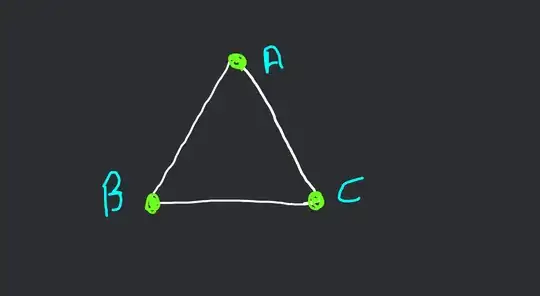For your system of charges we need to know the signs of the charges to determine the total potential energy. Let's assume are all positive point charges.
Starting with one charge fixed in position (say $Q_A$), the total potential energy is the sum of the work required by an external agent to bring each of the other charges (say $Q_B$, followed by $Q_C$) from $\infty$ to its position with respect to the other charge(s). The total potential energy is then
$$U_{tot}=\frac{1}{4\pi\epsilon}\biggl (\frac{Q_{A}Q_{B}}{r_{AB}}+\frac{Q_{A}Q_{C}}{r_{AC}}+\frac{Q_{B}Q_{C}}{r_{BC}}\biggr )$$
But my question is that since the potential energy between two
charges is stored in the space between them then why can't the
charge at C take away some of the potential energy of the system of
charges A and B i.e $U_{AB}$ ? What prevents this "theft" of energy
from happening ?
The potential energy between two charges is not stored in the space (electric field) between them. It is stored in the system of each pair of charges and the electric field between them.
You can think of the total potential energy of the system of three charges as the sum of the potential energies of three subsystems, or
$$U_{sys}=U_{AB}+U_{AC}+U_{BC}$$
Where
$$U_{AB}= \frac{Q_{A}Q_{B}}{4\pi\epsilon r_{AB}}$$
$$U_{AC}= \frac{Q_{A}Q_{C}}{4\pi\epsilon r_{AC}}$$
$$U_{BC}= \frac{Q_{B}Q_{C}}{4\pi\epsilon r_{BC}}$$
Since the potential energy of each subsystem is energy shared by the pair of charges and the field between them, if charge $Q_C$ is freed from its position to convert to kinetic energy, it takes with it the potential energy that charges $Q_A$ and $Q_B$ shared with it.
What you are calling "theft" is simply the loss of part of the potential energy of the initial system of charges due to the removal of whatever constraint is involved to keep one or more of them fixed in place. What "prevents" this "theft" is some external agent keeping the charges from moving away from each other due to repulsion, converting potential to kinetic energy.
Hope this helps.
